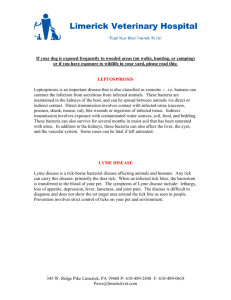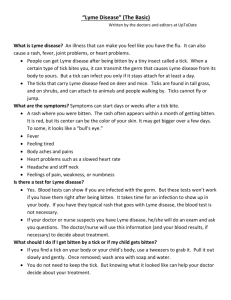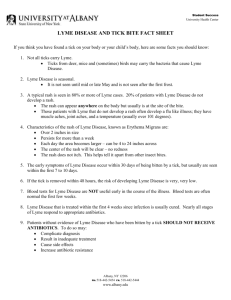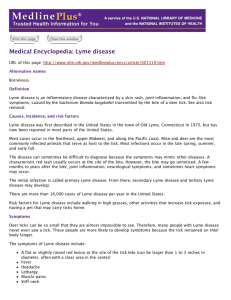Lyme Disease: Signs and Symptoms What is Lyme disease?
advertisement
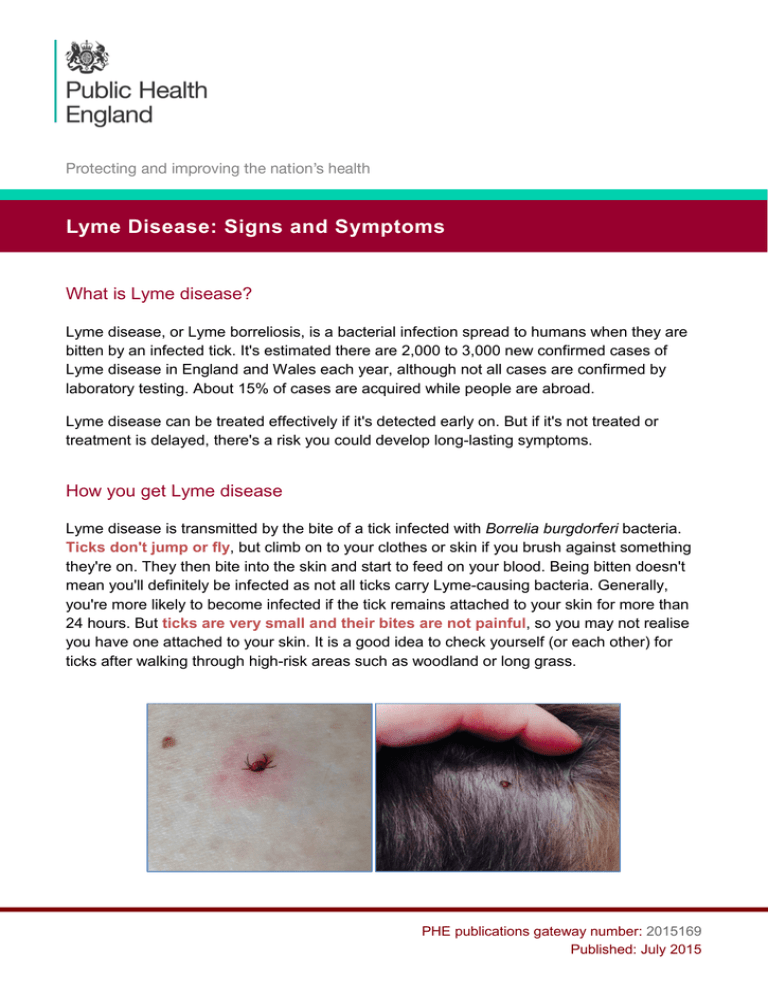
Lyme Disease: Signs and Symptoms What is Lyme disease? Lyme disease, or Lyme borreliosis, is a bacterial infection spread to humans when they are bitten by an infected tick. It's estimated there are 2,000 to 3,000 new confirmed cases of Lyme disease in England and Wales each year, although not all cases are confirmed by laboratory testing. About 15% of cases are acquired while people are abroad. Lyme disease can be treated effectively if it's detected early on. But if it's not treated or treatment is delayed, there's a risk you could develop long-lasting symptoms. How you get Lyme disease Lyme disease is transmitted by the bite of a tick infected with Borrelia burgdorferi bacteria. Ticks don't jump or fly, but climb on to your clothes or skin if you brush against something they're on. They then bite into the skin and start to feed on your blood. Being bitten doesn't mean you'll definitely be infected as not all ticks carry Lyme-causing bacteria. Generally, you're more likely to become infected if the tick remains attached to your skin for more than 24 hours. But ticks are very small and their bites are not painful, so you may not realise you have one attached to your skin. It is a good idea to check yourself (or each other) for ticks after walking through high-risk areas such as woodland or long grass. PHE publications gateway number: 2015169 Published: July 2015 Removing ticks If you do get bitten by a tick, remove it as soon as possible to reduce any potential risk. The safest way to remove a tick is to use a pair of fine-tipped tweezers, or a tick removal tool. Grasp the tick as close to the skin as possible to avoid leaving the head or mouthparts behind in the skin, then pull upwards slowly and firmly. Clean the bite site with an antiseptic wipe or wash with soap and water. If the tick’s head or mouthparts break off in the skin and cannot be removed, they should fall out naturally in time as the skin renews itself. Keep an eye on the area though, as it could cause a local infection. Once removed, apply antiseptic to the bite area, or wash with soap and water. A small red circular patch may appear soon after a tick bite and persist for a few days; this is normal. If the red patch does not disappear within a couple of weeks or begins to spread outwards, it may indicate Lyme disease Early symptoms of Lyme disease Many people with early-stage Lyme disease develop a distinctive circular rash at the site of the tick bite, usually around 3 to 30 days after being bitten. This is known as ‘erythema migrans’. The rash is often described as looking like a bull's-eye on a dart board. The affected area of skin will be red and the edges may feel slightly raised. The size of the rash can vary significantly and it may expand over several days or weeks. Typically it's around 15cm (6 inches) across, but it can be much larger or smaller than this. Some people may develop several rashes in different parts of their body. However, around one in every three people with Lyme disease do not report seeing a rash. Page 2 Lyme Disease: Signs and Symptoms As well as (or instead of) a rash, people with Lyme disease may experience one or more of the following: • • • flu-like symptoms: o tiredness (fatigue) o muscle pain o joint pains o headaches o a high temperature (fever) o chills o neck stiffness paralysis of the facial muscles, typically only on one side of the face (Bell’s palsy) Nerve pains, which may be sharp or prickly Later symptoms More serious symptoms may develop several weeks, months or even years later if Lyme disease is left untreated or is not treated early on. These can include: • • • • pain and swelling in the joints (inflammatory arthritis) problems affecting the nervous system – such as numbness and pain in your limbs, paralysis of your facial muscles, memory problems and difficulty concentrating inflammation of the membranes surrounding the brain and spinal cord (meningitis) – which can cause a severe headache, a stiff neck and increased sensitivity to light heart problems – such as inflammation of the heart muscle (myocarditis) or sac surrounding the heart (pericarditis), heart block and heart failure Some of these problems will get better slowly with treatment, although they can persist if treatment is started late. A few people with Lyme disease go on to develop a range of chronic symptoms despite treatment. It's not known exactly why this happens, but researchers are looking into possible causes. When to see your GP You should see your GP if you feel unwell with any of the symptoms described above after being bitten by a tick, or if you think you may have been bitten. Remember to let your GP know if you've spent time in areas where ticks may live. This includes woodland, grassland, heaths and some urban parks and gardens or allotments. Take this leaflet with you if you are unsure what to say. Page 3 Lyme Disease: Signs and Symptoms Diagnosing Lyme disease is often difficult as many of the symptoms are similar to other conditions. A spreading rash appearing some days after a known tick bite should be treated with appropriate antibiotics without waiting for the results of a blood test. Blood tests can be carried out to confirm the diagnosis after a few weeks, but these can be negative in the early stages of the infection. You may need to be re-tested if Lyme disease is still suspected after a first negative test result. If you have long-lasting symptoms, you may be referred to a specialist in microbiology, infectious diseases, rheumatology or neurology as appropriate. They can arrange for blood samples to be sent to the national reference laboratory run by Public Health England (PHE), where further tests for other tick-borne infections can also be carried out. Treating Lyme disease If you develop symptoms of Lyme disease, you will normally be given a course of antibiotic tablets, capsules or liquid. Most people will require a two- to three-week course, depending on the stage of the illness. If you are prescribed antibiotics, it's important you finish the course even if you are feeling better, because this will help ensure all the bacteria are killed. If your symptoms are particularly severe, you may be referred to a specialist to have antibiotic injections (intravenous antibiotics). There's currently no clear agreement on the best treatment for persisting symptoms because the underlying cause is not yet clear. Be wary of internet sites offering alternative diagnostic tests and treatments that may not be supported by scientific evidence. Further information More detailed information can be found on the NHS Choices website: http://www.nhs.uk/Conditions/Lyme-disease PHE information leaflet on preventing tick bites and removing ticks https://www.gov.uk/government/publications/tick-bite-risks-and-prevention-of-lyme-disease Lyme Disease Action has a website with information for patients, and offer a helpdesk for advice and support: http://www.lymediseaseaction.org.uk/ First published: July 2015 © Crown copyright 2015 Re-use of Crown copyright material (excluding logos) is allowed under the terms of the Open Government Licence, visit www.nationalarchives.gov.uk/doc/open-government-licence/version/2/ for terms and conditions. Page 4 Lyme Disease: Signs and Symptoms
